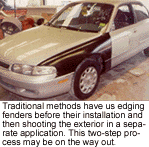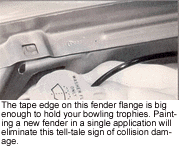Veterans in this business will recall that body shop practices were very different 30 years ago. For example, almost everything was masked in the paint department. In fact, the term R&I was almost unheard of, let alone being the contentious issue it is today. We taped everything. In fact, in the dealer shop where I first worked, we taped up Oldsmobile scripts, fine-lined moldings, antennas and car keys – OK, maybe not the keys. But we sure used a lot of tape.
Today, it’s another story. Removal and re-installation of trim, flush-mounted handles, glass and parts has become an industry standard. The insurance industry’s reluctance to compensate for the procedure aside, the expectations of your customers and the car-buying public demand higher-quality workmanship. And don’t be surprised to find it’s the collision repair market driving the trend.
Between those rising consumer expectations and the standards demanded by paint manufacturer refinish warranties, you could go so far as to say the naked paint edge has actually become a liability. Paint film is supposed to extend from edge to edge of the parts being painted. In fact, no paint maker will cover a failure from a technician’s negligence to remove flush-mounted handles or trim. It’s in their warranties.
Visible signs of repair, such as tape edges, are also linked to loss in resale value, which raises yet another concern for your customers. Add that to the risk of premature film deterioration and peeling, and you have a real mess on your hands. Simply put, the production methods of the mass-market discount auto paint franchises don’t belong in a contemporary collision repair facility.
Another vestige of past practices is far more ingrained: the two-step process for painting sheet-metal parts. In fact, if you’re still painting these parts twice because “that’s the way we’ve always done it,” you might want to think twice about that logic.
Is There Any Other Way?
In production shops, there’s the hard-to-shake belief that sheet-metal parts have to be painted twice (first the edges, jambs and undersides, and then the exterior surfaces). Most new hoods, fenders and door assemblies make a stop in the paint shop for edging before being handed off to the metal technicians for installation. This “two step” usually involves a painter mixing basecoat color for the edges, the application of a clearcoat and a dry cycle.
Once the trimmed parts are returned to the car and have undergone final fitting, the entire car heads back into the paint department where the dried paint surfaces on the inner flanges and undersides are masked before the exterior surfaces are sprayed in the booth. Again.
While there are some exceptions – such as bumper covers, which are almost always painted off the car – the two-step process is clearly the predominant production method. In fact, it’s so well-established there are modular “jambing” booths designed specifically for the separate paint application. Besides the process adding an entire step to the painting procedure, it also impacts energy usage and contributes to the shop’s waste stream.
Today more than ever, shop habits are subject to the scrutiny of an efficiency expert. In a business environment where facilities are hell-bent on reducing cycle time, you have to evaluate every process in the shop. What’s the impact of the two-step process for painting parts? Are we wasting time and material? Is the jambing of parts actually a contributor to the notorious production bottleneck in the paint department?
It would seem so. Yet, this twice-painted process shows little sign of fading from the production picture. Why? The answer we most often hear is “that’s the way we’ve always done it.” Also, many among us have strong convictions that painting sheet-metal parts off the car can’t be done practically.
Out with the Old and Off with the Parts?

In an attempt to gauge the industry’s acceptance of the idea of painting parts off the car, I interviewed a number of shop owners and production managers. Almost all envisioned their techs hammering up the newly painted fenders while they’re being force-fitted to the inner structure. Needless to say, there was a good deal of skepticism. One grizzled veteran from Texas (bound by habit to what is essentially a very wasteful process) simply insisted that it wouldn’t work. However – contrary to what he and many others may believe – it does work. Every day, in fact.
Interestingly, one of the shop owners I spoke with about the parts-off process actually changed his mind during the course of our conversation – essentially deciding it was a good idea after all. His shop is equipped with a side-loading booth with a separate drying compartment. Obviously, he’s interested in maximizing existing shop space and labor, so he’s fairly progressive in his approach. The aspect of the parts-off process that appealed to him was eliminating the time spent mixing basecoat and clear for the edging.
While the parts-off painting process has traditionally been the realm of high-end North American body and restoration shops, the fact remains they were paid for that level of expertise. Their customers expected more – and with those expectations came the understanding that their insurance companies would cover the costs. Today, however, a few production operations have also adopted the method. While it represents a fundamental change in culture as much as it does work habits, there are reports that the implementation of the parts-off process is yielding major-league time and material savings.
“To me it sounds like it makes a lot of sense,” says the president of a paint-performance tools manufacturer. “There would be a problem, though, if a customer expects to see that factory-applied tinted color primer under the hood. Actually, I think it would be a much better level of quality to see the outer body topcoats on undersides and fender flanges.”
One Stop in the Paint Shop
Manuel’s Auto Body in Bakersfield, Calif., has established parts-off painting as its normal routine. Starting last year, instead of pushing new parts around the body shop and through the paint shop twice in the repair cycle, Manuel’s became equipped with an oversized spraybooth where hoods, doors and fenders are set up on racks. The new parts are only painted once … and they’re done. But without the additional room in the booth, the one-step process would be impractical.
Where’d shop owner Manuel Oroz get the idea? The idea, he says, was his own but credits his paint company with helping him to organize his paint department to accommodate the one-stop paint shop process.
Don’t get the wrong idea about Manuel’s. While their quality is reported to be several notches above their competitors, it’s not a specialty shop that only does high-dollar vehicles; it’s a production facility that serves the general public. Cavaliers, Sentras, Caravans and Corollas all get the Rolls Royce treatment.
With the adoption of the parts-off system, Manuel’s has eliminated an entire step in the process, as well as its material cost and contribution to the waste stream. The bottom line is a dramatic reduction in cycle time for the operation, an upgrade in quality and lower material expense.
Using specialized racks, the new parts are finished at the same time as the repaired and blended panels on vehicle body. As you might expect, the process requires a high measure of discipline, organization and skill in the assembly phase of the repair – although Oroz says his assembly techs nick the parts far less often than you might imagine. The trick is to get the parts installed as soon as they’ve cooled from the bake cycle, due to the increased likelihood of damaging freshly painted parts while they’re waiting to be installed.
Eliminating a Step

Skeptical about the one-step process? Whether you believe this idea has practical applications in your operation is up to you. But if you decide it does, you may want to consider introducing the parts-off painting methods in stages. For example, instead of edging a new fender in the booth, try shooting the entire part before it’s installed. Because some compact cars’ fenders are more conducive to this arrangement than parts on some larger vehicles, ease your techs into it by having them start with easier parts first.
As the culture in your organization begins to change – and as your technicians learn to be more careful during the assembly stages – track the benefits. Imagine the cycle time reduction made possible by eliminating an entire step from the process? You just might find that despite the critics, not only is it possible – but it also pays – to create a one-stop paint shop.
Writer Charlie Barone has been working in and around the body shop business for the last 27 years, having owned and managed several collision repair shops. He’s an ASE Master Certified technician, a licensed damage appraiser and has been writing technical, management and opinion pieces since 1993. Barone can be reached via e mail at ([email protected]). For more information on production, visit our Web site at (bodyshopbusiness.com).













